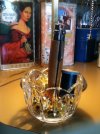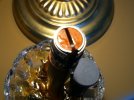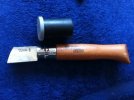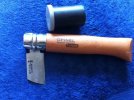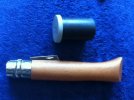- Joined
- Jul 17, 2011
- Messages
- 33
Hello all,
I've been lurking on this board for a long time, trying to learn as much as I can about traditional folder patterns. I'm looking for the perfect EDC- I do aspire to be a one-knife man- and although I've found that I like small two- or three-bladed jacks the most, my best knife right now seems to be a #8 Opinel. Anyway, I've been reading your tips about sanding the handle and treating it with linseed oil to waterproof it, but I could use some specifics about the oil. Should I brush it on? Soak it? How many times, and for how long, should I treat it? If I'm brushing it on, does an even coat matter, or will it all get soaked up anyway? Should I disassemble the knife completely before oiling the wood? I'm eager to learn about this stuff, but I really have no experience with fine woodworking, nor with knife-modding.
On a related note, I'm not used to a blade this thin. I usually strop my knives on my pulled-taut belt, but this blade is so slim, it seems really easy to mess up the angle. Any tips?
Thanks for your help- I'd appeciate any advice you can throw my way.
Mac
I've been lurking on this board for a long time, trying to learn as much as I can about traditional folder patterns. I'm looking for the perfect EDC- I do aspire to be a one-knife man- and although I've found that I like small two- or three-bladed jacks the most, my best knife right now seems to be a #8 Opinel. Anyway, I've been reading your tips about sanding the handle and treating it with linseed oil to waterproof it, but I could use some specifics about the oil. Should I brush it on? Soak it? How many times, and for how long, should I treat it? If I'm brushing it on, does an even coat matter, or will it all get soaked up anyway? Should I disassemble the knife completely before oiling the wood? I'm eager to learn about this stuff, but I really have no experience with fine woodworking, nor with knife-modding.
On a related note, I'm not used to a blade this thin. I usually strop my knives on my pulled-taut belt, but this blade is so slim, it seems really easy to mess up the angle. Any tips?
Thanks for your help- I'd appeciate any advice you can throw my way.
Mac





